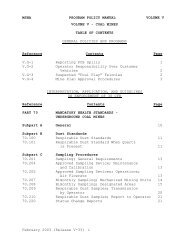MSHA HANDBOOK SERIES - PH13-V-1 - Mine Safety and Health ...
MSHA HANDBOOK SERIES - PH13-V-1 - Mine Safety and Health ...
MSHA HANDBOOK SERIES - PH13-V-1 - Mine Safety and Health ...
Create successful ePaper yourself
Turn your PDF publications into a flip-book with our unique Google optimized e-Paper software.
COAL MINE SAFETY AND HEALTH<br />
GENERAL INSPECTION PROCEDURES <strong>HANDBOOK</strong> CHAPTER 3<br />
produce coal on Saturday <strong>and</strong>/or Sunday, at least one Saturday or one Sunday<br />
should be included in each regular inspection. This step is intended to ensure<br />
that production shifts <strong>and</strong> crews are observed <strong>and</strong> inspected by the regular<br />
inspector during E01 inspections. Application of this procedure is m<strong>and</strong>atory<br />
only to the extent that resources are available within the district for the resulting<br />
overtime costs.<br />
Documentation Required: The inspector should document the mine shift(s) (day or<br />
1 st shift, afternoon or 2 nd shift, midnight or 3 rd shift, <strong>and</strong>/or weekend production shift)<br />
inspected each day on the cover sheet of inspection notes to identify the mine shift <strong>and</strong><br />
shift type (production, maintenance, or idle). When an operation works only two<br />
consecutive shifts, only two shifts are required to be documented in the ITS. The<br />
documentation requirements of this section are independent of any other documentation<br />
requirements.<br />
10. Part 47 Hazard Communication. Inspectors shall evaluate the mine operator’s<br />
compliance with Part 47 Hazard Communication (HazCom). The inspector will<br />
assure containers are properly labeled <strong>and</strong> Material <strong>Safety</strong> Data Sheets are<br />
available. The operator’s written program shall be reviewed.<br />
(Refer to Q&As Hazard Communication 2002; HazCom Inspection Procedures;<br />
HazCom Tool Kit 2002; <strong>and</strong> HazCom: 67 Fed. Reg. 42314 (June 21, 2002); for<br />
further guidance <strong>and</strong> additional information.)<br />
11. Mantrip Operation. The inspector shall evaluate mantrip operating practices<br />
for safety by observing at least one mantrip enter or exit the mine.<br />
12. <strong>Mine</strong> Rescue. An inspector shall inspect mine rescue team stations for<br />
capabilities <strong>and</strong> compliance with regulations quarterly, except for statemaintained<br />
mine rescue stations, which shall be inspected biannually. If an E01<br />
inspection is not open, the inspection may be conducted during a spot (E16)<br />
inspection. For mine rescue stations that cover more than one mine, the<br />
inspection can be conducted during an E01 or E16 inspection of any of the<br />
covered mines. Under these circumstances, to avoid duplication of mine rescue<br />
station inspections <strong>and</strong> to minimize confusion, the inspector must notify the<br />
field office supervisor(s) assigned to the mines <strong>and</strong> provide the event number,<br />
mine identification number, <strong>and</strong> the date of the inspection. If violations of 30<br />
CFR Part 49 Subpart B are found during the inspection, duplicate citations must<br />
be issued to each mine covered by the mine rescue station.<br />
Where inspection of mine rescue stations serving mines in different <strong>MSHA</strong><br />
Districts are performed, the mine rescue station should be inspected by<br />
personnel from either <strong>MSHA</strong> Districts, but not by personnel from both districts.<br />
To avoid duplication of <strong>MSHA</strong> inspections <strong>and</strong> minimize confusion as to which<br />
Release 1 (February 2013) 3-9
















